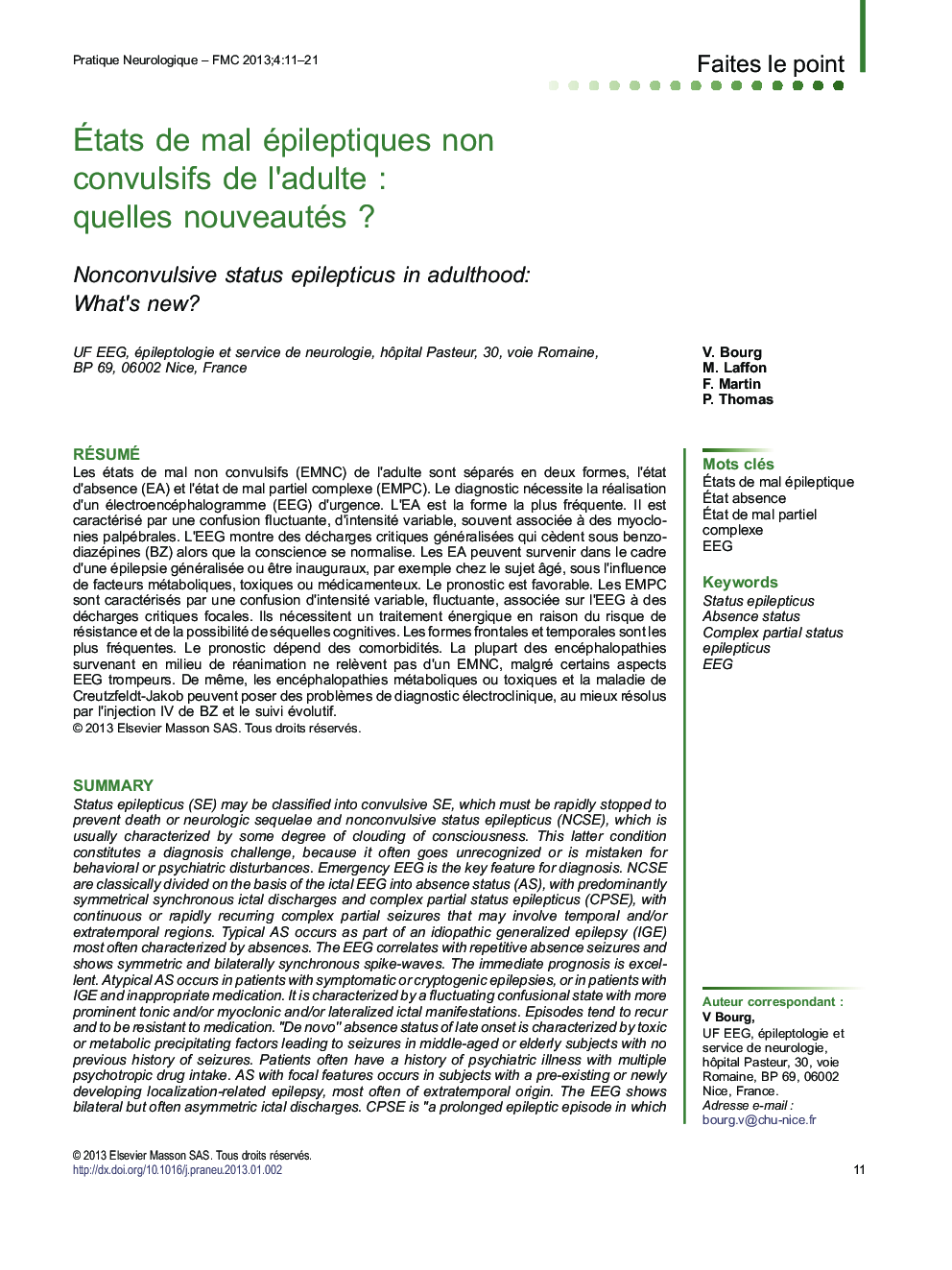| کد مقاله | کد نشریه | سال انتشار | مقاله انگلیسی | نسخه تمام متن |
|---|---|---|---|---|
| 3087303 | 1190068 | 2013 | 11 صفحه PDF | دانلود رایگان |
عنوان انگلیسی مقاله ISI
Ãtats de mal épileptiques non convulsifs de l'adulte : quelles nouveautés ?
دانلود مقاله + سفارش ترجمه
دانلود مقاله ISI انگلیسی
رایگان برای ایرانیان
کلمات کلیدی
موضوعات مرتبط
علوم زیستی و بیوفناوری
علم عصب شناسی
عصب شناسی
پیش نمایش صفحه اول مقاله

چکیده انگلیسی
Status epilepticus (SE) may be classified into convulsive SE, which must be rapidly stopped to prevent death or neurologic sequelae and nonconvulsive status epilepticus (NCSE), which is usually characterized by some degree of clouding of consciousness. This latter condition constitutes a diagnosis challenge, because it often goes unrecognized or is mistaken for behavioral or psychiatric disturbances. Emergency EEG is the key feature for diagnosis. NCSE are classically divided on the basis of the ictal EEG into absence status (AS), with predominantly symmetrical synchronous ictal discharges and complex partial status epilepticus (CPSE), with continuous or rapidly recurring complex partial seizures that may involve temporal and/or extratemporal regions. Typical AS occurs as part of an idiopathic generalized epilepsy (IGE) most often characterized by absences. The EEG correlates with repetitive absence seizures and shows symmetric and bilaterally synchronous spike-waves. The immediate prognosis is excellent. Atypical AS occurs in patients with symptomatic or cryptogenic epilepsies, or in patients with IGE and inappropriate medication. It is characterized by a fluctuating confusional state with more prominent tonic and/or myoclonic and/or lateralized ictal manifestations. Episodes tend to recur and to be resistant to medication. “De novo” absence status of late onset is characterized by toxic or metabolic precipitating factors leading to seizures in middle-aged or elderly subjects with no previous history of seizures. Patients often have a history of psychiatric illness with multiple psychotropic drug intake. AS with focal features occurs in subjects with a pre-existing or newly developing localization-related epilepsy, most often of extratemporal origin. The EEG shows bilateral but often asymmetric ictal discharges. CPSE is “a prolonged epileptic episode in which fluctuating or frequently recurring focal electrographic epileptic discharges, arising in temporal or extratemporal regions, result in a confusional state with variable clinical symptoms” (Shorvon, 1994). Various subtypes and precipitating factors are identified. Frontal and temporal localizations are most frequent in clinical practice. Limbic, non paraneoplastic encephalitis with VGKC autoantibodies has a characteristic clinical, MRI and immunological profile. In the recent years, many studies tend to lump together NCSE, “subtle” SE, AS, CPSE, myoclonic SE in coma, and EEG patterns suggestive of SE in comatose patients. In this group, the overall prognosis is poor, with a low response to antiepileptic drugs, but it may be particularly difficult to separate comorbidity to consequent morbidity. Post-hypoxic-ischemic encephalopathy, a life threatening condition that can express itself in the form of coma, EEG changes and myoclonus illustrates such methodological problems. NCSE should obviously be rapidly treated because of the attendant morbidity including physical injury, and because it may evolve on to generalized convulsions. Another argument is that long-term permanent neurologic damage from CPSE has been now documented, especially in the context of limbic encephalitis. IV benzodiazepines (BZ) must be performed first, with a rapid and complete recovery together with a normalization of EEG features. If BZ injection fails, IV fosphenytoin may be the drug of choice, especially in the context of symptomatic CPSE.
ناشر
Database: Elsevier - ScienceDirect (ساینس دایرکت)
Journal: Pratique Neurologique - FMC - Volume 4, Issue 1, February 2013, Pages 11-21
Journal: Pratique Neurologique - FMC - Volume 4, Issue 1, February 2013, Pages 11-21
نویسندگان
V. Bourg, M. Laffon, F. Martin, P. Thomas,